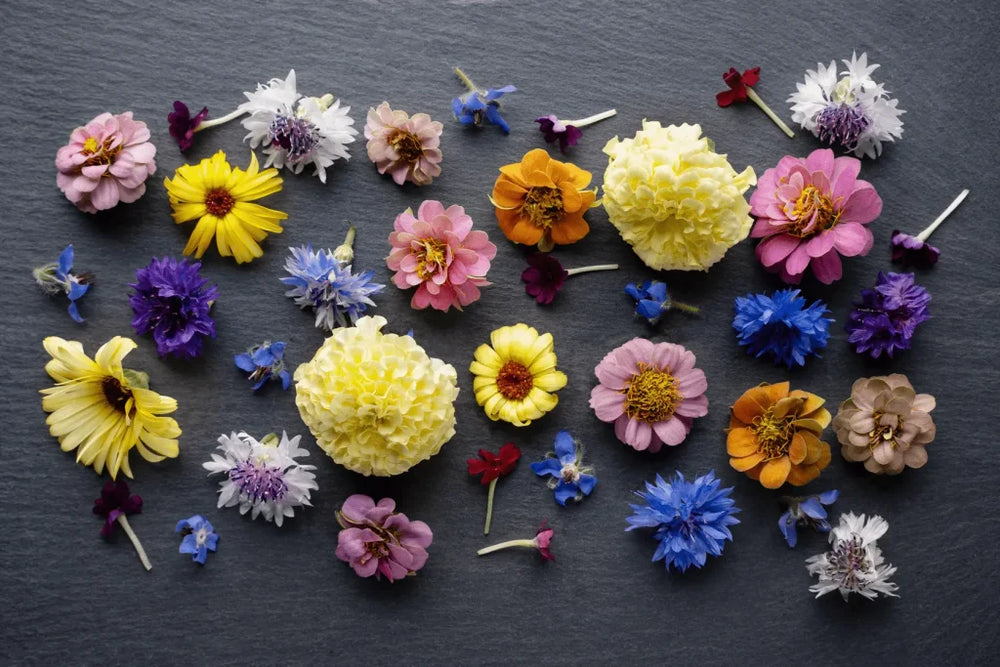
Edible flowers have long been a part of culinary culture worldwide, but their popularity has risen sharply over the last few years. With consumers looking for distinctive, natural, and visually stimulating ingredients, edible flowers are now part of gourmet meals, health potions, and even home cooking. Not only do these flowers add beauty to the food, but they also impart delicate flavors and health advantages that place them beyond mere garnish.
Let's see why there's so much demand for edible flowers and how they are good for our well-being.

Why Edible Flowers Are in High Demand
Edible flowers are now a trendy ingredient in upscale dining, home preparation, and specialty stores. Their colorful hues and subtle flavors give a touch of elegance to the dishes, and thus, edible flowers are a key ingredient in gourmet restaurants, patisseries, cocktails, and salads. The increasing popularity of plant-based and organic food has further boosted their demand, with people looking for natural, visually striking ingredients that both beautify and delight.
Moreover, social media sites such as Instagram and Pinterest have also been a huge contributor to the popularity of edible flowers. Food bloggers and chefs post pictures of their masterfully plated meals, and more people get encouraged to add floral garnishes to their home-cooked meals. As farm-to-table cooking and sustainable dining practices gain popularity, edible flowers continue to find a place for themselves in the culinary scene.
Nutritional and Health Benefits
Aside from aesthetics, edible flowers possess numerous health benefits. Some of them are high in antioxidants, vitamins, and essential nutrients, making them a functional food element. Examples include:
- Calendula has anti-inflammatory compounds and promotes skin health.
- Nasturtium is full of vitamin C and has antibiotic compounds.
- Dianthus has digestive benefits.
- Begonia gives a citrus flavor and promotes digestion and hydration.
By adding edible flowers to their diet, consumers can benefit from a combination of flavors and health benefits, making these flowers more than just an ornamental feature.
The Process of Growing Edible Flowers at Scale
Scaling up edible flower production starts with the initial step of choosing suitable varieties that are in demand by consumers, offer unique flavors, and are safe for consumption. Among the favorite edible flowers are
- Viola—Delicate, slightly sweet, and great for garnishing sweet courses.
- Snapdragon—With a slightly bitter taste, adding depth to salads and cocktails.
- Dianthus—Clove-like flavor, great for baked goods as well as infused syrups.
- Calendula—Peppery and colorful, perfect for both savory and sweet courses.
- Bachelor Button—Subtly grassy, usually employed for color contrast and visual appeal.
-
Begonia—Citrus tang, adding flavor to cocktails and fresh food.
Making sure these flowers are non-toxic and safe to eat is of utmost importance. Unlike decorative flowers, which can be treated with pesticides or other chemicals, edible flowers need to be grown carefully and under strict regulation to preserve their quality.
Controlled Environment Farming vs. Traditional Farming
In order to ensure high quality and availability throughout the year, most farms use controlled environment agriculture (CEA) rather than conventional outdoor farming. CEA has numerous benefits over conventional farming methods to provide the best growing conditions for edible flowers.
Controlled Environment Farming Advantages:
- Uniformity in Growth and Quality: By regulating conditions such as temperature, humidity, and light, farmers can have consistency in taste, size, and texture.
- Protection against Pests and Contaminants: Indoor farming minimizes the use of pesticides, keeping flowers safe to eat.
- Year-Round Supply: In contrast to traditional farming, which has to deal with seasonal fluctuations, CEA facilitates year-round production irrespective of the weather.
- Effective Space Use: Vertical farming practices make it possible to grow more flowers in less space, thereby optimizing yield.
Traditional farming is, however, susceptible to the vagaries of weather, pests, and unpredictable growing conditions, which makes it harder to mass-produce edible flowers without the use of chemicals.

Sustainable Practices in Large-Scale Flower Farming
- Hydroponic Systems: These water-conserving systems consume as much as 90% less water than conventional soil farming, without sacrificing plant health.
- Pesticide-Free Cultivation: Steer clear of synthetic pesticides not only to keep flowers safe for eating but also to safeguard pollinators and the environment.
- Energy-Efficient LED Lighting: Indoor farms often employ energy-efficient grow lights that offer the best light spectrums for growth while conserving energy.
- Compostable and Eco-Packaging: Sustainable farms focus on using biodegradable packaging materials to minimize waste and environmental footprints.
By adopting these practices, large-scale edible flower farms can ensure profitability while being environmentally responsible.
How Planted Detroit Grows High-Quality Edible Flowers
The Role of Vertical Farming
Planted Detroit has adopted vertical farming to grow high-quality edible flowers sustainably. Vertical farming enables resource optimization and utilization of space while maintaining high-quality production. Some of the key advantages of this method include:
- Optimizing Space Usage: By piling growing trays on top of each other vertically, Planted Detroit can grow more flowers in a smaller space.
- Climate Control: Light and humidity are carefully controlled to provide a stable environment for growth.
- Accelerated Growth Cycles: Growing cycles are minimized by controlled growing conditions, enabling multiple crops to be harvested annually.
- Water Waste Reduction: Hydroponic systems employed in vertical farming dramatically reduce water waste.
Harvesting and Quality Control
Harvesting flowers at the appropriate time is important to retain their flavor, color, and texture. We stick to a strict harvesting regimen:
- Flowers are harvested at optimal freshness to ensure their finest flavor and shelf life.
- Each bloom is quality-checked for appearance, flavor, and durability to premium standards.
- Flowers are treated gently to avoid damage and retain their fragile structure.
Packaging and Delivery
For freshness preservation, edible flowers are properly packaged in secure, food-grade containers. This guarantees that
- Flowers are not damaged or broken during transport.
- They arrive at their best usability for chefs and home cooks.
- Deliveries are fresh on Wednesdays to ensure optimal shelf life for customers.
How to Use Edible Flowers in Everyday Cooking
Edible flowers can take regular dishes to a new level, making them visually appealing and tasty. Edible flowers such as Viola and Bachelor Button provide a burst of color and delicate flavor in salads. Combinations of flower flavors with microgreens and produce of the season give the dish a fresh appeal. Incorporating flowers into pasta, risotto, and open-faced sandwiches gives the dish an air of sophistication.
Adding Flowers to Desserts and Cocktails
For sweets, Dianthus and Viola are favorites to use as cake, cupcake, and pastry decorations. They have delicate flavors that complement sweet ingredients, bringing both visual and subtle floral tastes.
For cocktails, Begonia adds a citrusy flavor, which pairs well with citrus-based cocktails, and Snapdragon can be used to add depth to floral-infused syrups and liqueurs. Edible flowers can also be frozen into ice cubes for an elegant presentation.

The Future of Edible Flower Farming
As edible flowers become more popular, controlled environment agriculture continues to be key to their sustainability. With cutting-edge methods and a focus on quality, farms such as Planted Detroit continue to raise the bar for freshness and innovation. The future of edible flower farming is bright, as technology and consumer demand fuel continued expansion in this specialized agricultural niche.
Enhance your dishes with Planted Detroit's collection of pesticide-free edible flowers. Check out our collection and order now to add exciting flavors and hues to your food. We would love to know how you incorporate edible flowers in your recipes! Share your dish on social media and tag us for a chance to be showcased. Let us all celebrate the art of floral food together!
